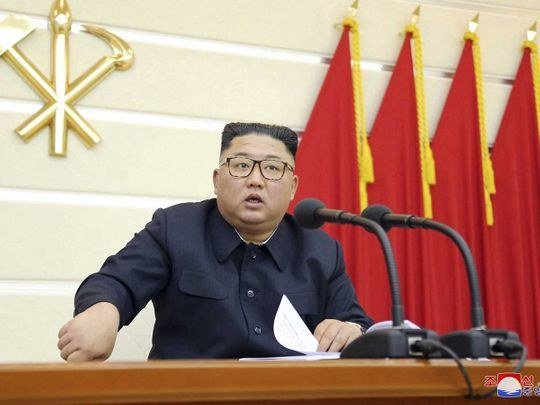
- ARAB NEWS
- 13 Jul 2025

Temporary disappearances by North Korean leaders are not uncommon, but they are always fodder for analysts trying to decipher the inner workings of a regime cloaked in secrecy. Kim Jong Un’s no-show this month at the Kumsusan Palace of the Sun to mark the birthday of his grandfather Kim Il Sung, the country’s founder, therefore triggered a rash of speculation about his health.
Pyongyang insists that everything is business as usual, while military and intelligence officials in the US, China and South Korea doubt the veracity of any reports to the contrary. Military forces across the borders in China and South Korea have not changed their posture, nor are they preparing to do so, which appears to confirm that Kim is still very much in charge, despite his last appearance being nearly two weeks ago.
Nevertheless, the speculation is unsurprising; along with Kim’s failure to appear at Kumsusan Palace, state media did not report the April 14 short-range missile launches in honor of Kim Il Sung, or whether party officials had an annual national meeting on the eve of the April 15 birthday. In addition, Kim Jong Un has no clear successor; if he dies, the inevitable instability would pose a major international risk.
In the past, changes in leadership have led to an increase in missile testing, external provocations, and internal purges to rein in dissent and demonstrate clout.
However, all this speculation delays a much-needed reassessment of the policies (or lack thereof) that have consistently failed to curb North Korea’s provocative activities.
Increasingly, Pyongyang is facing fewer international costs for shunning diplomatic overtures aimed at redressing this failure in favor of a new trajectory that would normalize relations on the peninsula, ease tensions in the Far East and provide sanctions relief. A resolution of the North Korea conundrum would also temper a thorny issue that has often divided the UN Security Council into two opposing camps, which cripples its decision making and enforcement of the few resolutions that it can still pass concerning North Korea.
After rounds of sanctions, failed talks, futile summits and even a first-of-its-kind “visit” by a serving US president, it is evident that “strategic patience” is not working. China, North Korea’s patron, is still keen on maximum enforcement of sanctions; nor will Beijing ever completely toe the line drawn by Washington, fearing a refugee crisis and deployment of US forces right on its borders should Pyongyang succumb to protracted instability.
Whether or not Kim Jong Un is alive or dead, it is the wrong question to be asking.
Hafed Al-Ghwell
If anything, years of strategic patience and gaps in sanctions enforcement have allowed Kim to develop and test missiles capable of delivering nuclear payloads to Japanese and US territory, reinforcing a deterrent that Pyongyang views as key to its survival. As a result, North Korea has become a de facto nuclear power, while the US and its allies continue to lose the ability to denuclearize the Korean Peninsula. Meanwhile the airwaves hum with talk of potential successors and what North Korea would look like without Kim at the helm, an exercise that makes sense only if the over-arching assumptions about the rogue state still hold.
However, widening gaps in military strength or demonstrations of swift annihilation capabilities will not persuade Pyongyang to abandon its nuclear ambitions. Rather, it depends on what the world collectively determines is the right course of action, and whether North Korea makes that decision on its own. Thus, a new framework is needed in which Pyongyang is offered a mix of incentives to limit its capabilities and disincentives for failure to do so — slowly establishing a new reality in which transparency and curbs are in its best interests.
This is not wishful thinking. Pyongyang has suggested before that with the right incentives it could freeze its nuclear programs. Trips to Beijing and Moscow and attempts at rapprochement with Seoul signal that Pyongyang is making room for diplomacy in place of the usual information blackouts, sudden test launches testing and outright provocations. Beijing has also expressed willingness to pressure Pyongyang to the negotiating table, but has not yet convincingly acted on it.
The consequences of ramping up nuclear capabilities may finally be apparent to Pyongyang — that is, using its nuclear weapons offensively guarantees the regime’s annihilation. Equally, while accepting North Korea’s nuclearization would be a bitter pill for any US administration to swallow, so would the massive loss of life in South Korea, Japan and parts of the US that would follow any attack, covert or otherwise, on the regime.
These are the discussions analysts and strategists should be having, instead of latching on to the latest rumor or whiff of intrigue from the notoriously secretive North Korean leadership. In the unlikely event that Kim Jong Un is indeed no longer in charge, the two potential successors — his sister and key aide, Kim Yo Jong, or his No2 Choe Ryong Hae — will probably persist with the same policies. It is therefore best to dispense with futile exercises discussing what-if scenarios on affairs in North Korea that are unlikely to change significantly regardless of who is in charge. What we should be talking about is a framework that would lead to a de-escalation in tensions and limiting further nuclearization of the Korean Peninsula.